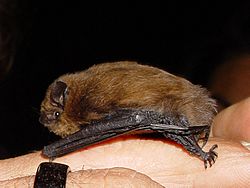Common pipistrelle facts for kids
Quick facts for kids Common pipistrelle |
|
|---|---|
 |
|
| Conservation status | |
| Scientific classification | |
| Kingdom: | |
| Class: | |
| Order: | |
| Suborder: | |
| Family: | |
| Genus: |
Pipistrellus
|
| Binomial name | |
| Pipistrellus pipistrellus |
|
The common pipistrelle (Pipistrellus pipistrellus) is a very small bat. It is a type of pipistrelle bat. This bat lives in many places. Its large home range includes most of Europe, North Africa, and parts of southwestern Asia. It might even live in Korea. It is one of the most common bats you can find in the British Isles.
In 1999, scientists made an interesting discovery. They found that the common pipistrelle was actually two different species! They realized this by listening to their special calls. Bats use sound to find their way around. This is called echolocation. The common pipistrelle makes a sound at 45 kHz. The other species, called the soprano pipistrelle, uses a 55 kHz sound. After this discovery, they also found other differences. These included how they look, where they live, and what they eat.
Contents
About the Common Pipistrelle Bat
The common pipistrelle is the smallest bat in Europe. It is a tiny creature.
Size and Appearance
This bat is about 3.5 to 5.2 centimeters (1.4 to 2.0 inches) long. This measurement is for its head and body. Its tail adds another 2.3 to 3.6 centimeters (0.9 to 1.4 inches). The common pipistrelle is also very light. It weighs only about 3.5 to 8.5 grams (0.12 to 0.30 ounces). Its wings can spread out wide. The wingspan is usually between 18 to 25 centimeters (7.1 to 9.8 inches). Its fur is brown, but the exact shade can change.
Where They Live
Common pipistrelles often live in woodlands and on farms. But you can also find them in towns. Female bats sometimes choose to live in lofts and buildings. They do this when they are raising their young bats.
How They Use Echolocation
Echolocation is how bats "see" with sound. The common pipistrelle sends out high-pitched sounds. These sounds bounce off objects. The bat then listens to the echoes. This helps them know where things are. It also helps them find insects to eat. The sounds this bat uses for echolocation are between 45 and 76 kHz. Most of the sound energy is at 47 kHz. Each sound burst lasts about 5.6 milliseconds.
Images for kids
See also
 In Spanish: Murciélago común para niños
In Spanish: Murciélago común para niños




